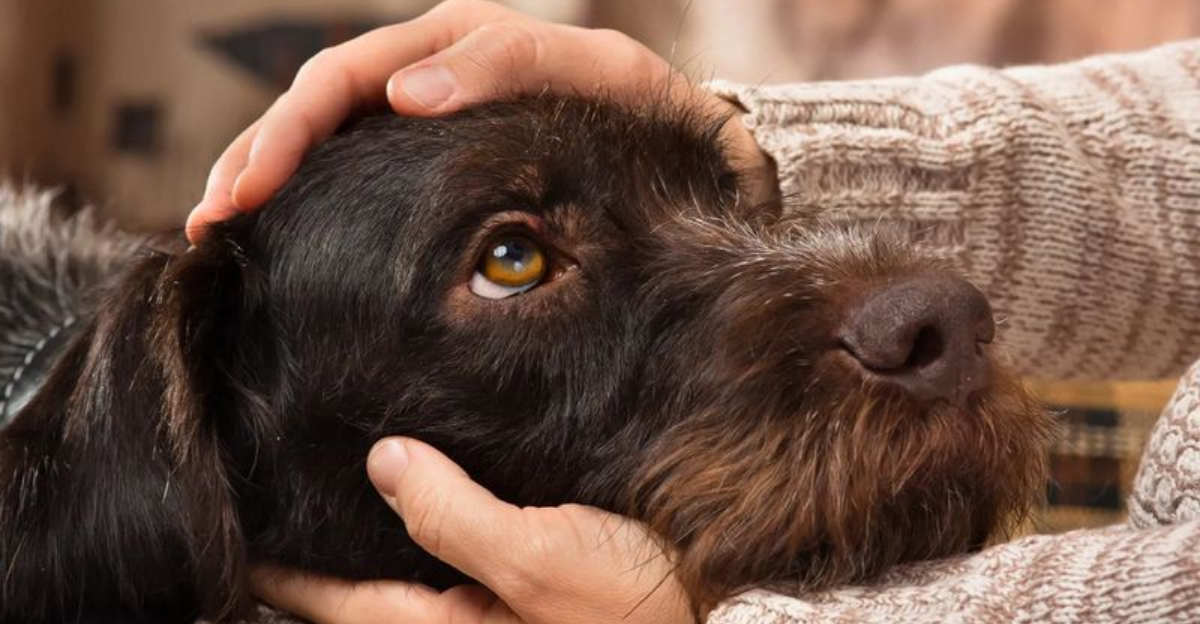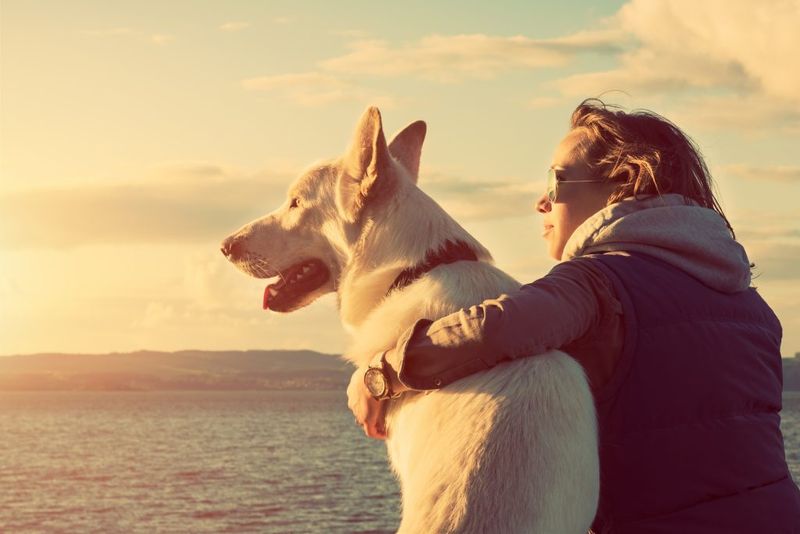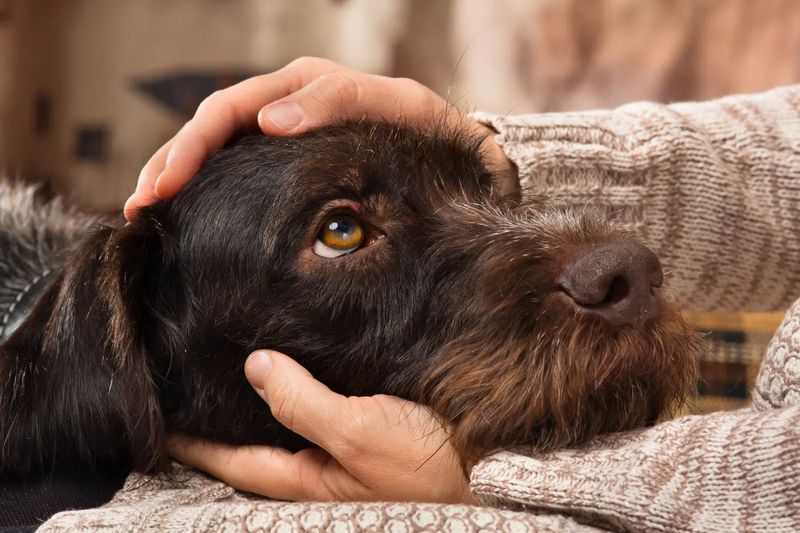7 Heartfelt Ways Dogs Say Goodbye Before Their Life Ends (And 7 Signs They’re Still Fighting)

Our loyal furry friends communicate with us until their final moments. Understanding these silent messages can help us provide comfort when they need it most.
Recognizing both farewell signals and signs of continued resilience allows us to make informed decisions about their care during life’s twilight phase.
1. Seeking Solitude And Isolation

Many dogs instinctively withdraw from family gatherings as they sense their time approaching. This ancient behavior stems from wild ancestors who would separate from the pack when vulnerable.
Your once-social companion might seek quiet corners, closets, or spaces under furniture. This isn’t rejection – they’re following deep-rooted instincts to protect you from witnessing their decline.
2. Unusual Clinginess Or Affection

A normally independent dog might suddenly become your shadow. This behavior shift signals their desire for comfort during vulnerability.
They may rest their head on you more frequently or position themselves to maintain physical contact. The reassurance of your touch provides security as they navigate unfamiliar sensations and emotions.
3. Giving You Their Favorite Toy

One of the most heartbreaking goodbye gestures comes when a dog brings you their most treasured possession. This isn’t ordinary play—it’s a deliberate gift.
Dogs understand possession and value. By offering their special toy, they’re entrusting you with something precious. It’s their way of leaving you a memento, ensuring a piece of their spirit remains in your keeping.
4. Final Visit To Special Places

Dogs approaching life’s end often make deliberate journeys to meaningful locations. Your pet might suddenly visit their puppy bed, favorite sunbathing spot, or the children’s rooms.
This behavior resembles a farewell tour—revisiting places that brought joy or comfort. They’re creating closure by connecting one last time with spaces that defined their life with you.
5. Peaceful Acceptance And Calmness

The anxious pacing or restlessness that often accompanies illness may suddenly cease. A strange serenity can descend as your dog accepts their journey’s end.
This tranquility doesn’t mean they’re giving up—rather, they’ve found peace. The fighting stops, replaced by quiet dignity. Their breathing steadies, and their expression softens into gentle acceptance.
6. Prolonged, Meaningful Eye Contact

Those soulful stares take on new significance near life’s end. Your dog might hold your gaze longer than usual, as if memorizing your face or communicating unspoken thoughts.
Scientists have confirmed that eye contact between humans and dogs releases oxytocin—the bonding hormone—in both species. This final connection represents their purest form of love and gratitude for your years together.
7. One Last Burst Of Energy

Some pets experience a mysterious surge of vitality shortly before passing. Your previously weak companion might suddenly eat heartily, play, or even attempt favorite activities from younger days.
Veterinarians call this terminal lucidity—a final rally before departure. While bittersweet, this gift allows shared joy one last time. Treasure this moment while recognizing its significance.
8. Still Greeting You At The Door

Fighting dogs maintain cherished routines despite discomfort. When your pup still musters energy to meet you at the door—even if they can barely stand—they’re showing remarkable resilience.
This effort demonstrates their commitment to family roles and responsibilities. They’re telling you they still find purpose in being your guardian and welcoming committee, regardless of physical limitations.
9. Responding To Their Name

Alert responses to verbal cues indicate cognitive engagement. A dog still turning toward their name or familiar commands shows their mind remains present.
This awareness signals they’re actively participating in life rather than withdrawing. Their ears might perk slightly, eyes track movement, or tail offer gentle wags—subtle yet meaningful signs they’re still connected to their world and family.
10. Attempting To Follow Routine

Structure provides security for dogs, especially during illness. When your companion insists on maintaining daily patterns—however modified—they’re demonstrating remarkable determination.
Perhaps they can only walk to the yard’s edge instead of completing their usual route. Maybe they still position themselves for mealtime despite appetite loss. These efforts reveal their fighting spirit and desire for normalcy.
11. Seeking Comfort, Not Isolation

While dying dogs often withdraw, fighters stay engaged with family. Their desire for proximity indicates they’re drawing strength from your presence rather than preparing for departure.
They might follow you between rooms despite fatigue or position themselves where they can monitor household activity. This social connection demonstrates they’re actively choosing to remain part of the family dynamic.
12. Showing Interest In Food

Appetite often vanishes during terminal decline. A dog who still shows food curiosity—even if they only lick or nibble offerings—displays vital life force.
They might not consume much, but their willingness to investigate treats or accept hand-feeding indicates they haven’t surrendered to illness. This fundamental drive connects directly to survival instinct and fighting spirit.
13. Attempting To Play

Play represents pure joy—the essence of doghood. When a sick pet initiates even modest play gestures, they’re expressing profound life affirmation.
Maybe they nudge a toy with their nose or attempt a playful bow. These might be shadows of their former exuberance, but they reveal an undefeated spirit. Their heart still finds space for happiness despite physical limitations.
14. Seeking New Experiences

Curiosity indicates engagement with life’s possibilities. A dog who still investigates unfamiliar scents or shows interest in new visitors hasn’t mentally checked out.
They might lift their head when someone new enters or sniff packages with interest. These small gestures reveal cognitive presence and emotional investment in their environment—clear evidence they’re actively participating in life.






